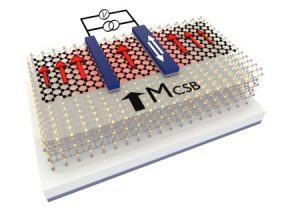
Graphene is a favoured amongst 2D materials for transporting spin information, but is cannot generate spin current unless its properties are modified – conventionally cobalt ferromagnetic electrodes are used for injecting and detecting the spin signal into graphene.
If graphene can be given magnetic properties, on its own it could favour the passage of one type of spin, tipping the balance between spin-up and spin-down electron population, creating a spin-polarised current.
And that is what Groningen has done in partnership with Colombia University.
Key to the discovery is the proximity of bilayer graphene to a CrSBr antiferromagnet interlayer.
“We detect an exceptionally large spin-polarisation of conductivity of 14% in the magnetic graphene that is also expected to be efficiently tuneable by a transverse electric field,” said Groningen researcher Talieh Ghiasi.
Unavoidable heat dissipation is for once a benefit.
“We observe that the temperature gradient in the magnetic graphene due to the Joule heating is converted to spin current,” said Ghiasi. “This happens by the spin-dependent Seebeck effect that is also observed in graphene for the first time in our experiments.” says Ghiasi.
Spin transport in the graphene is sensitive to the magnetic behaviour of the outer-most layer of the neighbouring antiferromagnet. “This implies that such spin transport measurements enable read-out of the magnetisation of a single atomic layer,” according to the university. “Thus, the magnetic graphene-based devices not only address the most technologically-relevant aspects of magnetism in graphene for the 2D memory and sensory systems, but also provide further insight into the physics of magnetism.”
The work is covered in ‘Electrical and thermal generation of spin currents by magnetic bilayer graphene‘, published in Nature Nanotechnology.
Image: a simplified schematic showing electrical and thermal generation of spin currents in a bilayer graphene-CrSBr heterostructure. Magnetic cobalt electrodes are used to determine the degree of proximity induced spin polarisation in the bilayer graphene, where the magnetisation of the outer-most layer of CrSBr allows for higher conductivity of spin-up electrons (red arrows).